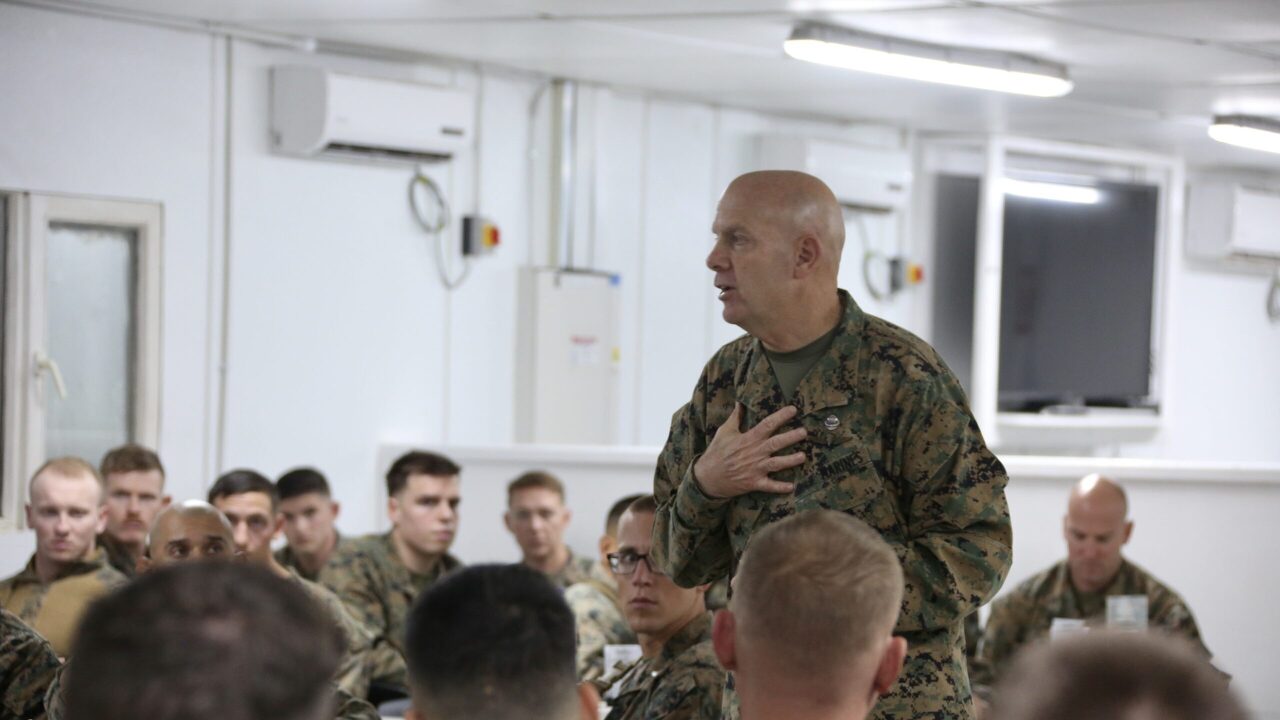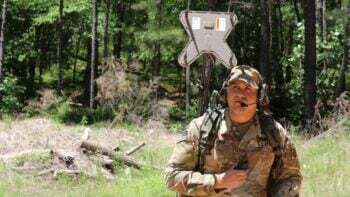
Marine Commandant Gen. David Berger speaks to Marines and sailors at Camp Shorab, Afghanistan. (U.S. Marine Corps photo by Sgt. Olivia G. Knapp)
WASHINGTON — Marine Corps Commandant Gen. David Berger has been careful to not publicly jump to conclusions about the war in Ukraine. But he recently admitted one aspect of the nearly 10-month-old conflict that is sinking in: It’s a long, brutal “slugfest.”
“The amount of ordnance in a conflict like this,” he said, “just the quantities I think surprised some people because I believe some had read for 20 years [about] precision strike and … deep, long range [weapons] meant we’re just going to fire a few of these very precise things and the war would be over.”
“The war is not like that,” he added.
The commandant, who is approaching the homestretch of his time leading the US Marine Corps, sat down on Wednesday with a large group of reporters and took questions on everything from the war in Ukraine and China’s naval capability to Force Design 2030 and his interactions with lawmakers.
Theory Of Force Design Showing Itself In Ukraine
Since the war in Ukraine began in late February, most senior military officers are asked about it at least once whenever they are speaking in public forums. With Berger sitting in a room full of national security reporters, Wednesday was no different. Berger has made a redesign of how the Marine Corps fights in the future, Force Design 2030, a keystone project for his tenure as commandant and was asked if what’s happening in Ukraine validates some of the concepts.
“Yes, I think what we’re seeing … in Ukraine has validated some of the approaches we’re taking,” he said. “I’m not into blanket statements, like everything that’s happened in the Ukraine is the answer all around the world. But much of what we’re seeing in Ukraine is agnostic of what theater, what part of the world we’re operating in.”
In May Berger noted how “ubiquitous” intelligence, surveillance and reconnaissance had become on a modern battlefield. This week he said he is even “more convinced” of that assessment.

Better, smarter UAS have intelligence and resilience for denied operations
Continued operation in RF environments — whether that’s GPS denial or communications disruption — is the number one need for tactical unmanned aerial systems.
“We have to be distributed. You have to have enough mobility that you can relocate your unit pretty often,” he said. “You have to learn all about, like some of us learned 30 years ago, camouflage, decoys [and] deception.”
What wasn’t found on a battlefield decades ago were hundreds of small devices held by every combatant that constantly emit easy-to-track signals, otherwise known as cellphones. Getting younger Marines to understand how such devices can endanger their lives in a conflict is a new challenge.
“They don’t ever think anything about pressing a button,” he said. “This is what they do all day long. Now, we have to completely undo 18 years of communicating all day long and tell them that’s bad, that will get you killed. So, turn your cell phone off.”

A recent CSIS wargame explored potential outcomes of a China-Taiwan-US conflict. (Graphic by Breaking Defense; original image of wargame map courtesy CSIS; original photograph by Ashley Pon/Getty Images)
China’s Time To Act On Taiwan? No One Can Know For Sure

Open systems architecture can unlock ‘limitless potential:’ Army Undersecretary
Army Undersecretary Gabe Camarillo said he was particularly impressed by the service’s adoption of the C5ISR Modular Suite of Standards program, a platform that will allow soldiers to plug in cards embedded with networking and EW capabilities
The potential for China making a move to forcibly take Taiwan has been the subject of premonitions by analysts and senior military officers alike for several years now, with the alarm bells only becoming more frantic based on what lessons China may have taken from the NATO response to the situation in Ukraine.
On Wednesday, Berger said he’ll never be satisfied with US preparations for such a scenario because at the end of the day, “you never know when the other side is going to move.”
“If I said I’m comfortable with the way things are going, then you might believe I know exactly when the Chinese might move,” he said. “I don’t.”
In terms of China’s ability to move, Berger said he believes the US still has the upper hand in terms of capabilities, but he added that China is “moving quickly” to expand their capacity.
“They’re doing their own sort of force design… and investing more in amphibious formations,” he said. “That’s a good signal where they’re headed. They want to go out into the world and do things… They’re building an amphibious force so they can project power.”
Amphibs, Amphibs, Amphibs
No discussion with the most senior Marine is complete without talking about the service’s favorite type of ship: the amphibious kind. The commandant said senior Defense Department leadership in recent years has become much more aware of industrial base capacity.
“I don’t think we were cavalier about it — it wasn’t as big of a focus as it is right now. Now, industrial capacity, diversity, there’s a discussion like every week and it never was before,” he said.
Berger also said he was encouraged by language in this year’s National Defense Authorization Act in which lawmakers clearly delineated the role the Marine Corps commandant should play in determining the requirements for amphibious ships.
“That’s a very positive thing… Congress understands that that’s a service requirement. So, [they] want to hear from the service what you need,” he added.
Berger didn’t directly address the amphibious ship study the Navy and Marine Corps have been working on this past year, but Navy Secretary Carlos Del Toro told reporters on Tuesday the study was being briefed to senior Pentagon leadership and he “hopes” it would be delivered to Capitol Hill within the next month.
Speaking Of Congress…
Despite a loud chorus of critics of the changes in Force Design 2030, Berger has maintained relatively unified public support from Congress for his ideas and approach. He credited the good relationships with lawmakers to advice he got early on to constantly communicate with key committee members and staffs.
Berger argued if the Pentagon is going to convince lawmakers, not just about Force Design 2030 but any kind of new experimentation, then the services need to be more willing to let lawmakers see the process.
“We should be willing for you to stand next to us and go, ‘Well, that didn’t work very well. Okay, what are you going to do next?’ And that doesn’t mean failure. That means we’re learning fast,” he said.
He specifically called out classified wargames as a potential avenue for such collaboration, noting most members have sufficient security clearances to observe those events.
“We haven’t blocked them out, but we also haven’t invited them in,” he said. “We need to.”

Gen. Robert Neller (right), Gen. David Berger’s predecessor as Marine Corps Commandant, speaks alongside then-Chief of Naval Operations Adm. John Richardson. Berger has often credited Neller with foreseeing the issues that prompted Force Design 2030.
Force Design After Berger
The commandant has credited his predecessor, Gen. Robert Neller, with foreseeing many of the problems that Force Design 2030 is aiming to fix. But, undoubtedly, it is Berger who set the changes in motion and has been the one defending it from critics when necessary.
But with the commandant likely to retire next summer when his time as the senior Marine Corps officer ends, what will happen to his keystone project? Berger said there are two parts to making sure the effort doesn’t crumble in the days following his retirement. The first is simply to make sure the changes are “right.”
But more importantly, he added, the key is to make sure there’s room for adjustments based on whatever the next commandant might see coming.
“All 15 [senior Marine Corps generals] are part of the debate,” he said, referring to the relatively small cadre of active duty three- and four-star Marine Corps officers. “How do you ensure it [stays] when you leave? …You build in the mechanisms, the confidence that there’s a way to constantly test, evaluate, reassess, and make changes along the way.”




